Day 1 of a three day Winter Tour in Norfolk today. It was very wet overnight, but the rain passed through by morning and the cloud gradually broke to leave a day of blue skies and winter sunshine. Great weather for winter birding!
As we drove west this morning, we could see lots of White-fronted Geese in a field by the road at Holkham but unfortunately there was nowhere to stop and we had several cars behind us. A little further on, a Barn Owl was hunting over a grassy meadow next to the road, and it turned to cross right in front of us. Thankfully we were already going slowly, as we only narrowly avoided it and it saw us at the last minute.
A large flock of Pink-footed Geese was flushed from a potato field by the farmer just before Burnham Overy as we approached and flew over the road ahead of us. We turned inland in the village, and just beyond we found a small mixed flock of Greylags and Pink-footed Geese in a muddy field by the road. It was quieter here, and we could pull up to have a quick look from the minibus. It was a good chance to see the two species side by side.
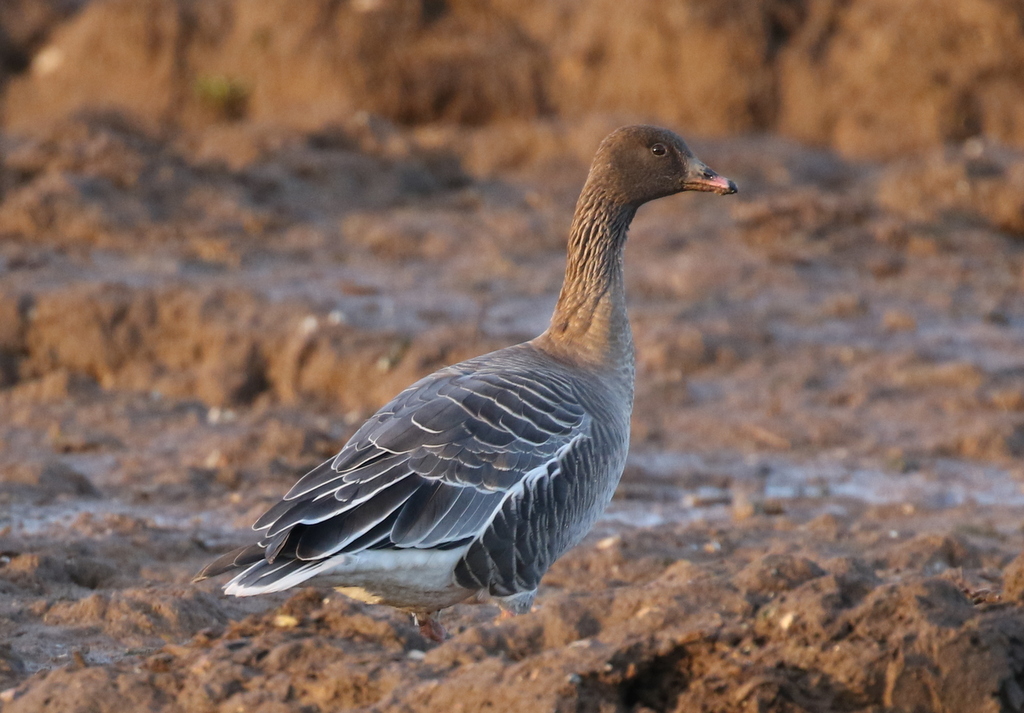
Our first stop of the morning was at Sedgeford. There were a few cars already parked along the verge and as we got out of the minibus we were told the Eastern Yellow Wagtail had been seen earlier by its favoured muck heap down along the track opposite. But when we got to the small group of birders gathered there, they seemed to be unsure whether it had been seen or where it had gone.
It normally flies in here eventually, so we stopped to wait. There were several Brown Hares in the field opposite and a large gathering of Common Gulls feeding up on the ridge. A Yellowhammer came over calling. A Sparrowhawk flew along the hedge line at the far end. We could see lots of Fieldfares in the field back towards the road, but they flew back and disappeared behind the ridge back towards where we were parked.
We had a lot to try to do today and we figured we could always call in to try for the wagtail again on our way back later, so we walked back towards the road to have a look for the Fieldfares. When we got back there, we discovered that the Eastern Yellow Wagtail had earlier flown in with a couple of Pied Wagtails and landed in the field right next to where everyone was parked. A couple of people had been watching it while everyone else was standing down the track by the muck heap. But the birds had flown off again and although the two Pied Wagtails had returned, their rarer cousin had disappeared again.
We could see the Fieldfares out in the field, so got those in the scopes, feeding with a rather jumpy flock of Starlings. There were several Red-legged Partridges behind and a flock of Linnets and Goldfinches in the set aside strip along the field margin. A Bullfinch flew over calling and landed in the hedge, where we got it in the scope, a very smart pink male.
Knowing that the Eastern Yellow Wagtail was around now, we decided to walk back to the muck heap, hoping that it would now fly back in there. We were just walking up when we heard it call and it landed in the edge of the field right next to where everyone was standing. We had great views of it now, as it picked around on the bare mud – well worth the wait!

Eventually the Eastern Yellow Wagtail flew up calling – the diagnostic rasping call, very unlike our regular Western Yellow Wagtails and more like a Citrine Wagtail – and dropped down onto the muck heap. We took this as a cue to move on.
Our next stop was at Snettisham. There were a few Goldeneye and Little Grebes on the pits on the way in. When we got up onto the seawall, the tide was out – high tide was in the early hours this morning. We were not here mainly for the waders today though, our target was Short-eared Owl. As we made our way round, we scanned the brambles and quickly found one hidden in some long grass – it was hard to see, but eventually everyone managed to get onto it.
We decided to push our luck again, and walked on a little further. There was a second Short-eared Owl, hiding in the same place we had seen it last week, under a rather sparse bramble bush. Even better, we looked back at the first Short-eared Owl and with the change of angle we now found we were looking straight at it out in the open. We had a great view of it through the scope.
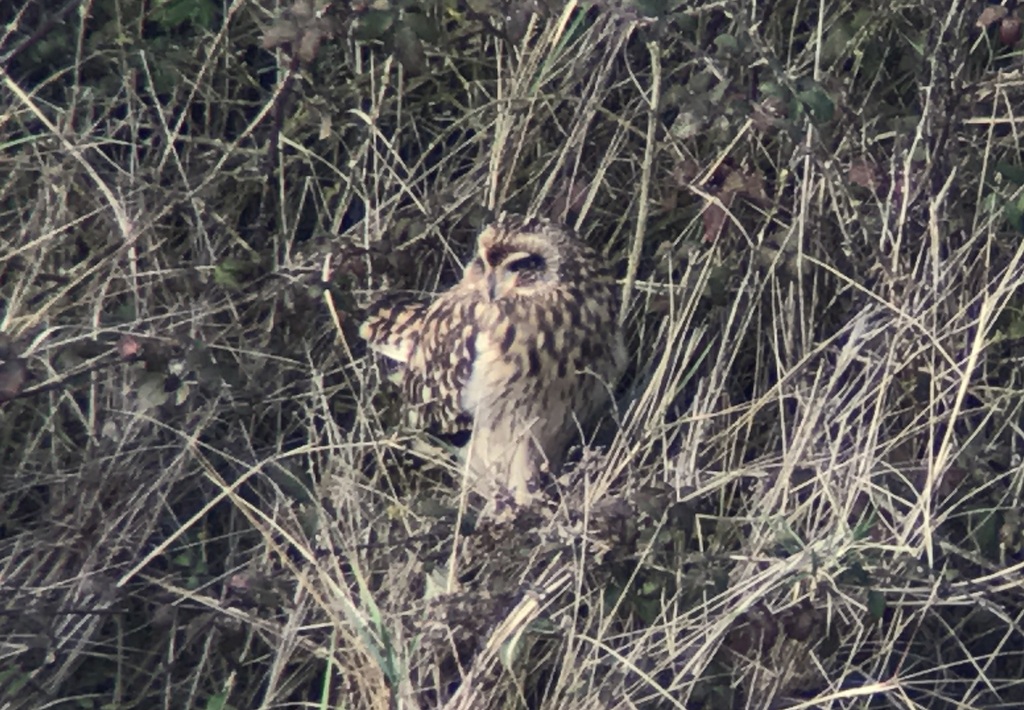
Scanning the main pit, we could see a good selection of wildfowl – more Goldeneye, Tufted Ducks, several Wigeon and a few Gadwall and Shoveler. The Swan Goose hybrid was in with the Greylag Geese again. A flock of a few hundred Pink-footed Geese came up from the Wash and flew over calling noisily.
Turning our attention to the Wash, most of the Knot and Bar-tailed Godwits were way off in the distance, but we could see quite a few Dunlin out on the mud quite close in despite the fact that the tide was out. We decided to have a quick look through the Dunlin, pointing out that we had seen a Little Stint here with them several times last winter, when the very next bird we saw was… a Little Stint! What a coincidence!
The Little Stint was feeding with the Dunlin, and was much smaller when they were seen side by side, with a shorter, finer bill. They are mainly passage migrants here, and rare in winter. It was in exactly the same area we had seen the Little Stint last year, so perhaps it it is the same bird come back here for a second winter.
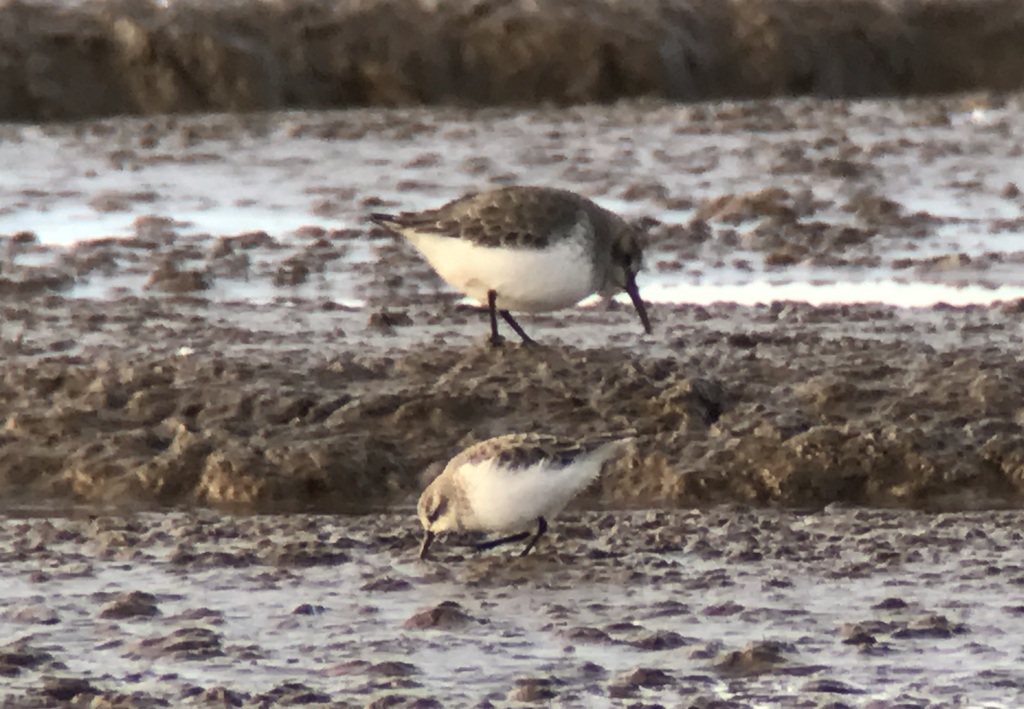
There were one or two Grey Plover quite close in too. With the sun now coming out, we could see a large flock of Golden Plover out on the mud, packed tightly together in a long line, shining in the low winter’s light. There were lots of Lapwing too, darker, and scattered more liberally over the mud.
We had lots we wanted to do today, so we moved on. We called in for a quick stop at Thornham Harbour, but we were told the Twite which had been there earlier had disappeared. There were quite a few people there and there were not many waders in the harbour channel either – a couple of Redshank and Curlew, and a single Oystercatcher. A couple of Brent Geese were out across the saltmarsh towards the beach.
We walked up to the old sluice and had just stopped to scan the saltmarsh when we heard the distinctive nasal twang of a Twite calling back behind us, somewhere beyond the car park. We turned to see a small group of birds perched on the vegetation on the far side of the harbour channel but before we could get back they had taken off. They landed back down on the saltmarsh a bit further back, disappearing out of view.
We stood and scanned for a bit. A couple of Rock Pipits flew over. A few Linnets flew in and out and when a larger flock flew over, we heard Twite calling again. Two birds landed on the cross bar of one of the wooden jetties on the edge of the harbour and conveniently they were a Twite and a Linnet next to each other – another great comparison.
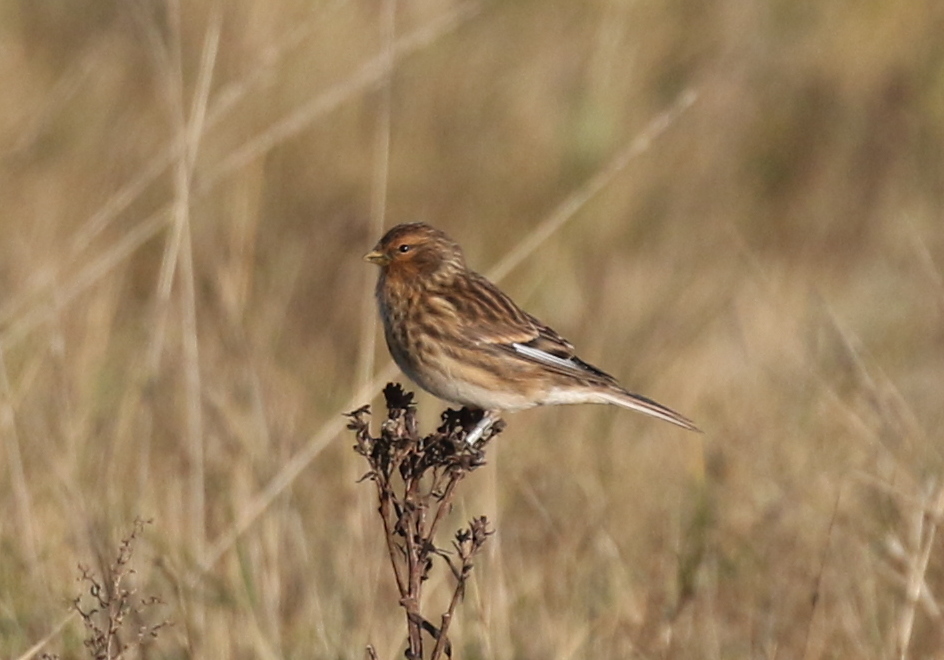
We had a good look at them through the scope before the Twite flew down and landed on the other side of the channel directly opposite us. We could see its yellow bill and its burnt orange breast caught the sun. It seemed to be on its own and when the Linnets flew up again, the Twite flew back over to join them. One was enough – we decided to head round to Titchwell for lunch.
After lunch, we headed straight round to Meadow Trail. We were told the Woodcock was in its usual spot and when we got there we didn’t have to look for it – a crowd was gathered there and lots of long lenses were pointed in its direction. Thankfully the throng quickly dwindled so we could find a spot where we could all admire it. It was not far from the boardwalk and clearly relying on its cryptically patterned plumage for camouflage, probably convinced that we couldn’t see it.
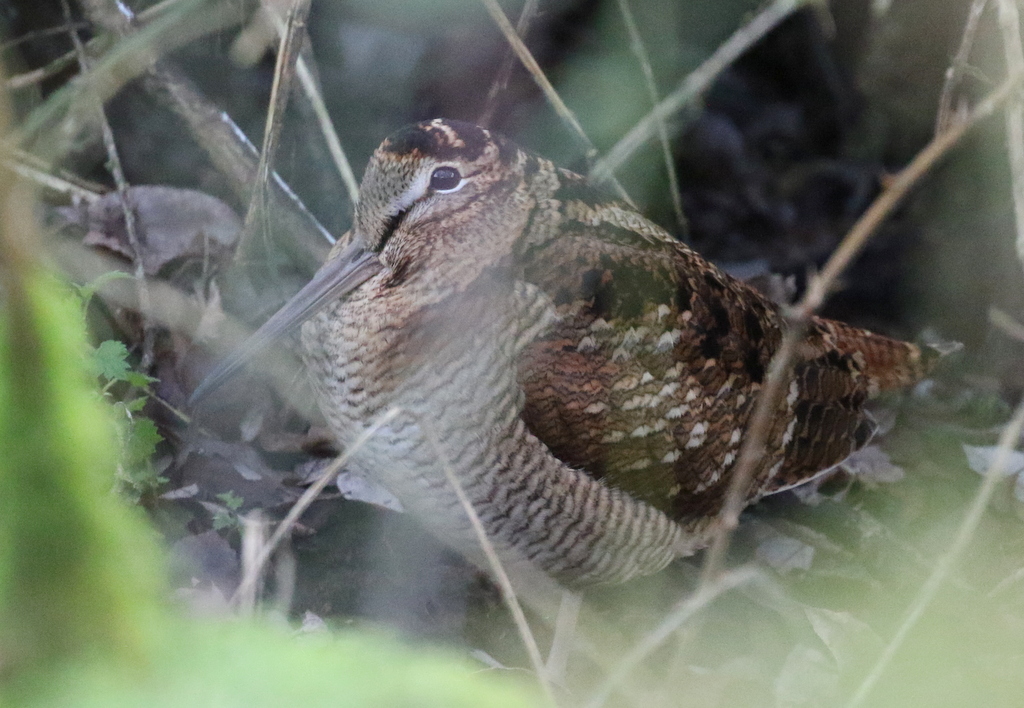
We moved on, to create space for the next Woodcock admirers, and headed round to the main path. We could see a Marsh Harrier out beyond the reedbed and lots of Greylags and a couple of Mute Swans on the reedbed pool. The Freshmarsh is still full of water, although with the sluice apparently now repaired, the water level has started to drop. There were lots of ducks on there, including a single drake Goldeneye.
Time was running short, so we continued straight out to the Tidal Pool. A single Spotted Redshank was feeding up to its belly in the far corner – through the scope, we could see its long bill and bright supercilium as it lifted its head. A Bar-tailed Godwit walked across in front of it. A Turnstone was picking around on one of the islands next to a couple of Black-tailed Godwits.
A little further up, we stopped to look at all the Bar-tailed Godwits roosting on the spit. There were several Grey Plovers in with them and scanning with the scope we found a couple of Knot too. There were a few ducks out on the water and, in with all the Mallard, we could see five Pintail. We got a pair in the scope and the drake looked especially stunning in the low afternoon sunlight. As it upended, we could see its long, pin-shaped tail.
We had one more thing we wanted to do today, so we needed to head back. We had to make a brief stop as we passed the Freshmarsh to train the scope on one of the drake Teal on the bank. Again the light was perfect and the plumage detail through the scope was exquisite.
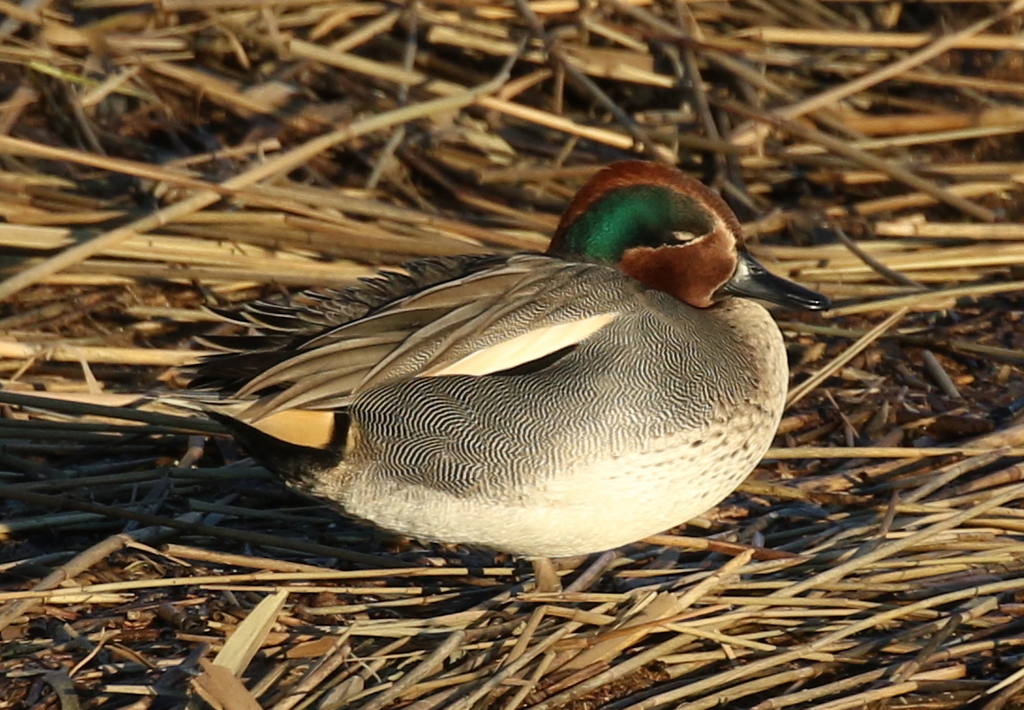
Titchwell had one more gift to give us today. As we got back into the trees, we looked down into the ditch beside the path to see a Water Rail picking along the far bank of the water in the bottom. A Chiffchaff was calling in the bushes in the car park as we made our way round to the minibus.
Our last stop of the day was back at Wells. As we got out of the minibus, a Short-eared Owl was down in the grass on the edge of the ditch a short way down the track. We got it in the scope and could see its yellow eyes as it looked round. We didn’t know which was to look, as the Rough-legged Buzzard was on its usual bush off towards the bank in the other direction. We got the scopes set up, some on each, and everyone moved between them admiring the two birds.

The Short-eared Owl took off and flew a bit further back, landing back down in the grass again. Then we looked over to the bank by the Rough-legged Buzzard to see a Barn Owl appear. It dropped down to the ground on the bank and came up again with a vole in its talons, disappearing with it into the bushes where the Rough-legged Buzzard was still perched.
A Common Buzzard had now landed in the grass where the Short-eared Owl had been and the latter had taken offence. We watched as it flew up repeatedly, before swooping down at the Buzzard, pulling up at the last minute. The Buzzard eventually decided it had had enough, flying off with the Short-eared Owl in pursuit, before the owl turned back and circled up and over the bank.
There was a stunning moonrise this evening – it is a full moon tonight, a ‘wolf moon’, the first full moon of the New Year. We decided to walk down the track to the bank to admire it. A Grey Heron was motionless at the back of the first flood, looking rather like a wooden post in the gloom. As we passed one of the grassy fields, two small birds circled over and dropped in – two Water Pipits. Unfortunately they immediately disappeared into the long grass.
From up on the bank, we got the scope on the Rough-legged Buzzard. With the change in angle, we were now looking at it back on, and could see the white base to its tail. We looked away and it took off – we watched it fly off towards the pines, presumably heading off to roost, longer, slimmer-winged and longer-tailed than a Common Buzzard.
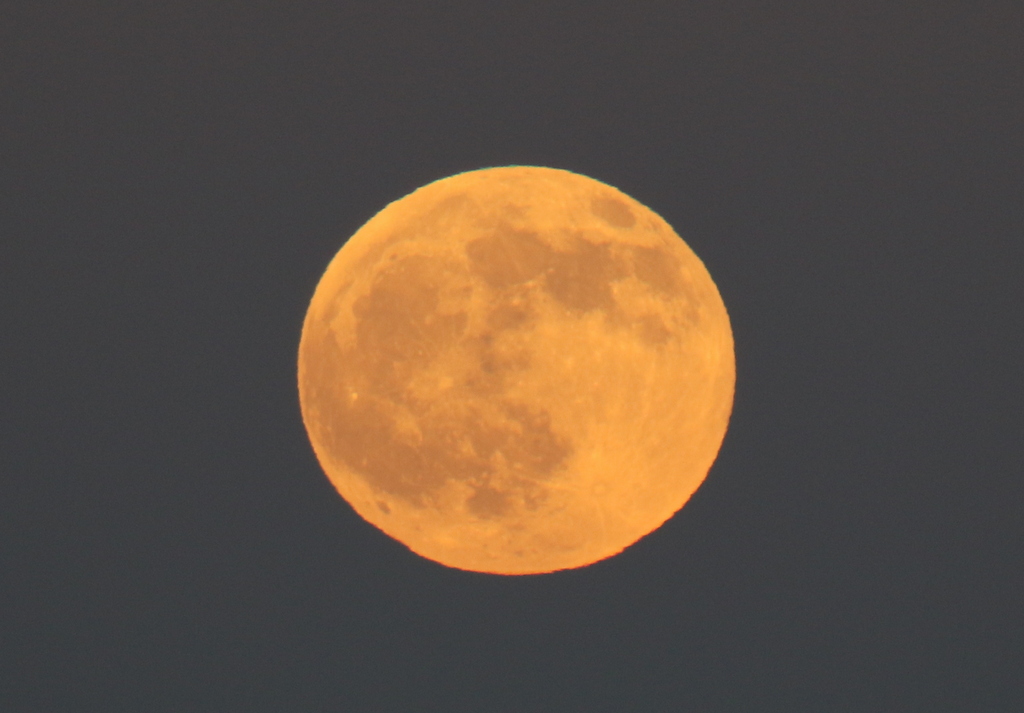
We took that as our cue to head for home too. As we walked back, with the full moon away to our left and the last yellow light of the sunset illuminating the sky away to our right, the Short-eared Owl was still hunting over the grassy field beside the track and a Grey Partridge was calling in the stubble the other side. A great way to wrap up our first day.
















